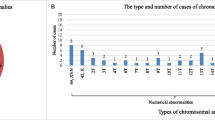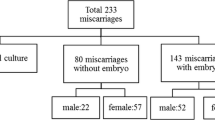Abstract
Purpose
The purpose of this study is to perform a retrospective analysis of types and frequencies of chromosomal abnormalities detected by conventional cytogenetic studies in first-trimester miscarriages after spontaneous conception and IVF.
Methods
Standard cytogenetic analysis of GTG-banded chromosomes obtained from products of conception (POCs): semi-direct and short-term cultured chorionic villi or long-term cultured fetal mesodermal cells.
Results
50.1% of first-trimester miscarriages in the studied group had chromosomal abnormalities: 59.7% of trisomies, 22% of poliploidies, 7.5% of monosomies, 7% of unbalanced structural abnormalities, and 3.8% of multiple aneuploidies. An increase in the frequency of chromosomally abnormal miscarriages was observed in the group of women above 40 when compared to groups of women under 35 (P < 0.05). No difference in frequencies and types of chromosomal abnormalities in POCs of miscarriages after ICSI and spontaneous conception was observed.
Conclusions
Approximately, 50% of first-trimester miscarriages have chromosomal abnormalities which can be detected by conventional cytogenetic analysis. The presence of chromosomal abnormality may explain the cause of miscarriage, improving the reproductive counseling and planning.


Similar content being viewed by others
References
van den Berg MM, van Maarle MC, van Wely M, Goddijn M. Genetics of early miscarriage. Biochim Biophys Acta. 2012;12:1951–9.
Jenderny J. Chromosome aberrations in a large series of spontaneous miscarriages in the German population and review of the literature. Mol Cytogenet. 2014;7:38.
Wu T, Yin B, Zhu Y, Li G, Ye L, et al. Molecular cytogenetic analysis of early spontaneous abortions conceived from varying assisted reproductive technology procedures. Mol Cytogenet. 2016;9:79.
Bianco K, Caughey AB, Shaffer BL, Davis R, Norton ME. History of miscarriage and increased incidence of fetal aneuploidy in subsequent pregnancy. Obstet Gynecol. 2006;107:1098–102.
Blakemore KJ, Watson MS, Samuelson J, Dreg WR, Mahoney MJ. A method of processing first-trimester chorionic villous biopsies for cytogenetic analysis. Am J Hum Genet. 1984;36:1386–93.
Zhang YX, Zhang YP, Gu Y, Guan FG, Li SL, et al. Genetic analysis of first-trimester miscarriages with a combination of cytogenetic karyotyping, microsatellite genotyping and arrayCGH. Clin Genet. 2009;75:133–40.
Dhillon RK, Hillman SC, Morris RK, McMullan D, Williams D, et al. Additional information from chromosomal microarray analysis (CMA) over conventional karyotyping when diagnosing chromosomal abnormalities in miscarriage: a systematic review and meta-analysis. BJOG. 2014;121:11–21.
Shimokawa O, Harada N, Miyake N, Satoh K, Mizuguchi T. Array comparative genomic hybridization analysis in first-trimester spontaneous abortions with 'normal' karyotypes. Am J Med Genet A. 2006;140:1931–5.
Lin SB, Xie YJ, Chen Z, Zhou Y, JZ W, et al. Improved assay performance of single nucleotide polymorphism array over conventional karyotyping in analyzing products of conception. J Chin Med Assoc. 2015;78:408–13.
Sahoo T, Dzidic N, Strecker MN, Commander S, Travis MK, et al. Comprehensive genetic analysis of pregnancy loss by chromosomal microarrays: outcomes, benefits, and challenges. Genet Med. 2017;19:83–9.
Rajcan-Separovich E. Chromosome microarrays in human reproduction. Hum Reprod Update. 2012;18:555–67.
Shetty S, Gogate A, Gogate S, Malet P. A reproducible modified method for direct preparation of chorionic villi cytogenetic analysis. Methods Cell Sci. 2003;25:149–54.
Rooney D. Human cytogenetics: constitutional analysis. A practical approach. 3rd ed. Oxford: University Press; 2001.
Doria S, Carvalho F, Ramalho C, Lima V, Francisco T, et al. An efficient protocol for the detection of chromosomal abnormalities in spontaneous miscarriages or foetal deaths. Eur J Obstet Gynecol Reprod Biol. 2009;147:144–50.
Kroon B, Harrison K, Martin N, Wong B, Yazdani A. Miscarriage karyotype and its relationship with maternal body mass index, age and mode of conception. Fertil Steril. 2011;95:1827–9.
Petracchi F, Colaci DS, Igarzabal L, Gadow E. Cytogenetic analysis of first trimester pregnancy loss. Int J Gynaecol Obstet. 2009;104:243–4.
Choi TY, Lee HM, Park WK, Jeong SY, Moon HS. Spontaneous abortion and recurrent miscarriage: a comparison of cytogenetic diagnosis in 250 cases. Obstet Gynecol Sci. 2014;57:518–25.
Shearer BM, Thorland EC, Carlson AW, Jalal SM, Ketterling RP. Reflex fluorescent in situ hybridization testing for unsuccessful product of conception cultures: a retrospective analysis of 5555 samples attempted by conventional cytogenetics and fluorescent in situ hybridization. Genet Med. 2011;13:545–52.
Lathi RB, Milki AA. Rate of aneuploidy in miscarriages following in vitro fertilization and intracytoplasmic sperm injection. Fertil Steril. 2004;81:1270–2.
Menasha J, Levy B, Hirschhorn K, Kardon NB. Incidence and spectrum of chromosome abnormalities in spontaneous abortions: new insights from f 12-year study. Genet Med. 2005;7:251–63.
Rodriguez-Purata J, Lee J, Whitehouse M, Moschini RM, Knopman J, et al. Embryo selection versus natural selection: how do outcomes of comprehensive chromosome screening of blastocysts compare with the analysis of products of conception from early pregnancy loss (dilation and curettage) among an assisted reproductive technology population? Fertil Steril. 2015;104:1460–6.
Lomax B, Tang S, Separovic E, Phillips D, Hillard E, et al. Comparative genomic hybridization in combination with flow cytometry improves results of cytogenetic analysis of spontaneous abortions. Am J Hum Genet. 2000;66:1516–21.
Subramaniyam S, Pulijaal VR, Mathew S. Double and multiple chromosomal aneuploidies in spontaneous abortions: a single institutional experience. 2014:7;262–268.
Bettio D, Venci A, Levi Setti PE. Chromosomal abnormalities in miscarriages after different assisted reproduction procedures. Placenta. 2008; Suppl B:126–8.
Demko ZP, Simon AL, McCoy RC, Petrov DA, Rabinowitz M. Effects of maternal age on euploidy rates in a large cohort of embryos analyzed with 24-chromosome single-nucleotide polymorphism-based preimplantation genetic screening. Fertil Steril. 2016;105:1307–13.
Franasiak JM, Forman EJ, Hong KH, Werner MD, Upham KM, et al. The nature of aneuploidy with increasing age of the female partner: a review of 15,169 consecutive trophectoderm biopsies evaluated with comprehensive chromosomal screening. Fertil Steril. 2011;101:656–63.
Wang Y, Cheng Q, Meng L, Luo C, Hu H, et al. Clinical application of SNP array analysis in first-trimester pregnancy loss: a prospective study. Clin Genet. 2016; https://doi.org/10.1111/cge.12926.
Lathi RB, Gustin S, Keller J, Maisenbacher MK, Siqurjonsson S, et al. Reability of 46,XX results on miscarriage specimens: a review of 1,222 first trimester miscarriage specimens. Fertil Steril. 2014;101:178–82.
Neusser M, Rogenhofer N, Dürl S, Ochsenkühn R, Trottmann M. Increased chromosome 16 disomy rates in human spermatozoa and recurrent spontaneous abortions. Fertil Steril. 2015;104:1130–7.
Nagaishi M, Yamamoto T, Iinuma K, Shimomura K, Berend SA, et al. Chromosome abnormalities identified in 347 spontaneous abortions collected in Japan. J Obstet Gynaecol Res. 2004;30:237–41.
Fragouli E, Alfarawati S, Spath K, Jaroudi S, Sarasa J, et al. The origin and impact of embryonic aneuploidy. Hum Genet. 2013;132:1001–13.
Pellestor F, Anahory T, Hamamah S. The chromosomal analysis of human oocytes. An overview of established procedures. Hum Reprod Update. 2005;11:15–32.
Taylor TD, Noguchi H, Totoki Y, Toyoda A, Kuroki Y, et al. Human chromosome 11 DNA sequence and analysis including novel gene identification. Nature. 2006;440:497–500.
Hassold T, Arnovitz K, Jacobs PA, May K, Robinson D. The parental origin of the missing or additional chromosome in 45,X and 47,XXX females. Birth Defects Orig Artic Ser. 1990;26:297–304.
Nagaoka SI, Hassold TJ, Hunt PA. Human aneuploidy: mechanism and new insights into age-old problem. Nat Rev Genet. 2013;13:493–504.
Hassold T, Hunt P. To err (meiotically) is human: the genetics of human aneuploidy. Nat Rev Genet. 2001;2:280–91.
Li S, Hassed S, Mulvihill JJ, Nair AK, Hopcus DJ. Double trisomy. AJMG. 2004;124A:96–8.
Qy L, Tsukishiro S, Nakagawa C, Tanemura M, Sugiura-Ogasawa M, et al. Paternal origin and cell stage of non-disjunction of double trisomy in spontaneous abortion. Congenit Anom (Kyoto). 2005;45:21–5.
Bernardini L, Gianaroli L, Fortini D, Conte N, Magli C, et al. Frequency of hyper-, hypohaploidy and diplody in ejaculate, epididymal and testicular germ cells of infertile patients. Hum Reprod. 2000;15:2165–72.
Durak Aras B, Aras I, Can C, Topak C, Dikogly E, et al. Exploring the relationship between the severity of oligozoospermia and the frequencies of sperm chromosome aneuploidies. Andrologia. 2012;44:416–22.
Author information
Authors and Affiliations
Corresponding author
Rights and permissions
About this article
Cite this article
Pylyp, L.Y., Spynenko, L.O., Verhoglyad, N.V. et al. Chromosomal abnormalities in products of conception of first-trimester miscarriages detected by conventional cytogenetic analysis: a review of 1000 cases. J Assist Reprod Genet 35, 265–271 (2018). https://doi.org/10.1007/s10815-017-1069-1
Received:
Accepted:
Published:
Issue Date:
DOI: https://doi.org/10.1007/s10815-017-1069-1




